This post contains affiliate links.
I admit to previously dismissing Saskatchewan as a flat open prairie, with miles of straight roads and grain elevators. My impression was largely formed on a road trip from Ontario to BC, driving the Trans-Canada Highway, back in 1987, when I first moved to Vancouver. Miles of mind numbing straight prairie roads, at the wheel of my ’77 buckskin coloured Monte Carlo, with a Meatloaf “Bat Out of Hell” 8-track tape blasting the sound system to stay awake, took a toll. I wasn’t much interested in stopping.
That impression was further reinforced by Canadian folk music and comedic performer Connie Kaldor, crooning about her Saskatchewan birthplace, and the foibles of prairie life.
The Discover Saskatchewan indigenous tourism mission
So it was a delight to return to Saskatchewan in June 2025, with a fresh set of eyes. Our host Jodi Holliday, from Tourism Saskatchewan, assured me that the experience she had planned – seeing Saskatchewan through an Indigenous lens, would blow my mind. And it did. She was also determined to break me of the habit of pronouncing it “SaskatcheWAN”. Proving ultimately teachable, I learned to squish the ending together in something that more closely resembles “SaskatcheWIN”, clipped at the end, like a good prairie girl chopping wheat.
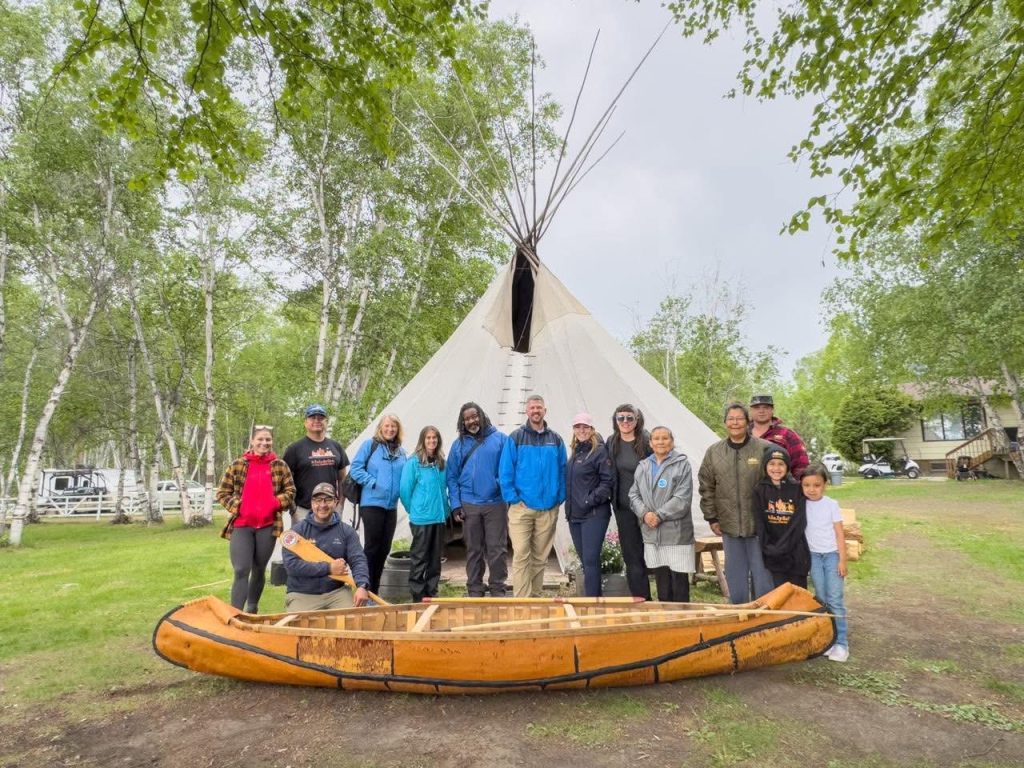
Our journey north of Saskatoon, took us to the heart of the boreal forest, a land laced with hundreds of lakes, and a rich indigenous culture rooted in the land. Our group was part of a pre-conference media tour for the Travel Media Association of Canada. My fellow travel journalists were a rock star lot, hand selected by Jodi for their media reach, but also fun loving, roll with the punches attitude. Who else would you take on a trip that warned accommodations one night would include an outhouse?
Canada has much to learn from its Indigenous populations. As people who are spiritually mature, rooted in community and connected to the land, the matriarchal underpinnings of indigenous society also teaches us compassion for each other, care for mother earth, and how soft power is earned through respect.
Saskatchewan Indigenous Tourism at kâniyâsihk Culture Camps
All of this was on display at kâniyâsihk Culture Camps, located on Ministikwan Lake Cree Nation, the traditional territory of Treaty 6. The camp is remote, 80km west of Meadow Lake, but a land rich with Cree history and traditions.
The camp’s main focus is on preserving traditional ways, and educating younger generations, as well as non-indigenous populations, curious to explore. Founded on a fear that the traditional Cree ways of hunting, fishing, cooking, creating and storytelling were slipping away, the culture camp is a place to keep those things alive.
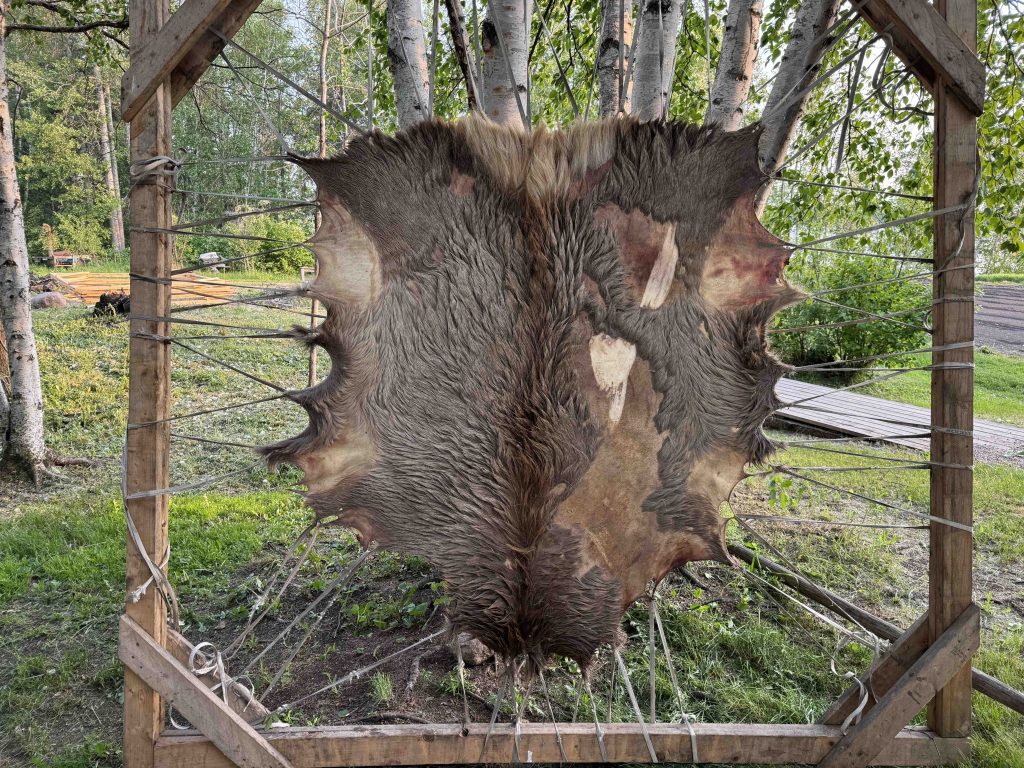
When we pulled up, I initially thought we had stopped at someone’s house. Any inkling of a formal camp entrance was missing. Instead we happened onto a group of family members, gathered around a cooking tent. Darla and Carmen would be our hosts, plus Zak, and Kevin our main guide, who we would meet later. A tipi in the background, fire pit circle, some hides strung out on stretchers, and a lake in the distance rounded out the scene. Notably, cell service had dropped on the way in. It would be a cell phone free experience, which Kevin encouraged. Starlink wifi was available by the tipi for emergencies, but I chose never to connect. The decision to be fully present was intentional, but also freeing.
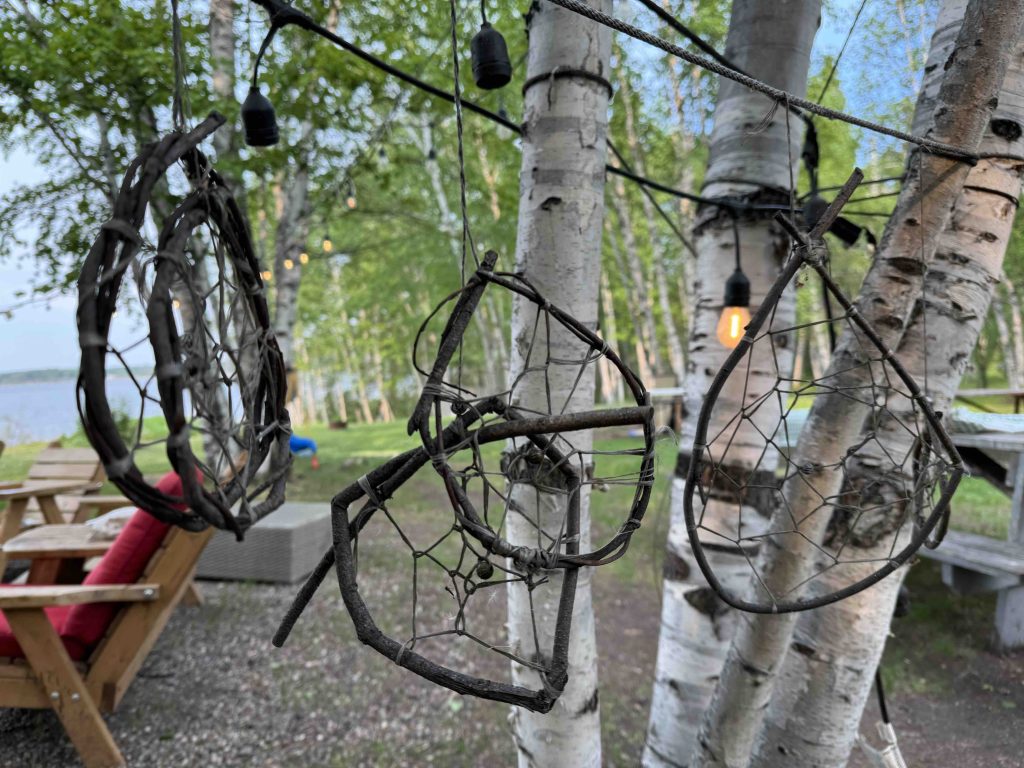
With the wind howling off the lake, a warm lunch took the edge off. We stood around getting to know our hosts while eating, and then later dropping our bags at the accommodations for the night – newly built bunk cabins close to the lake. Two outhouses were across the way. Jodi wasn’t kidding. Our crew had signed up for rustic, in exchange for a truly one of a kind authentic Indigenous experience.
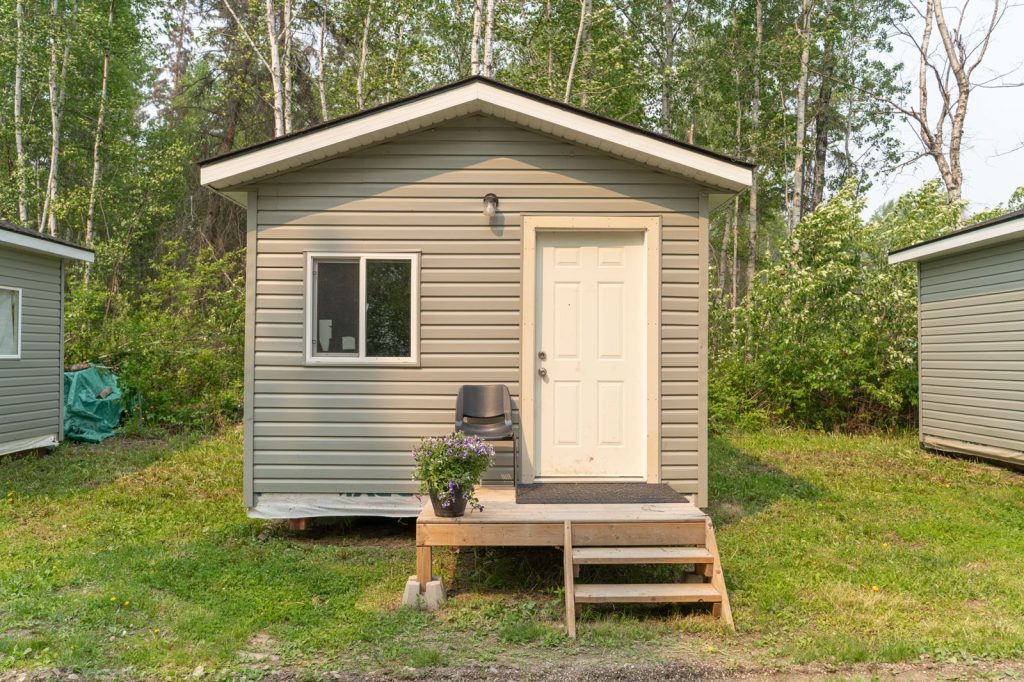
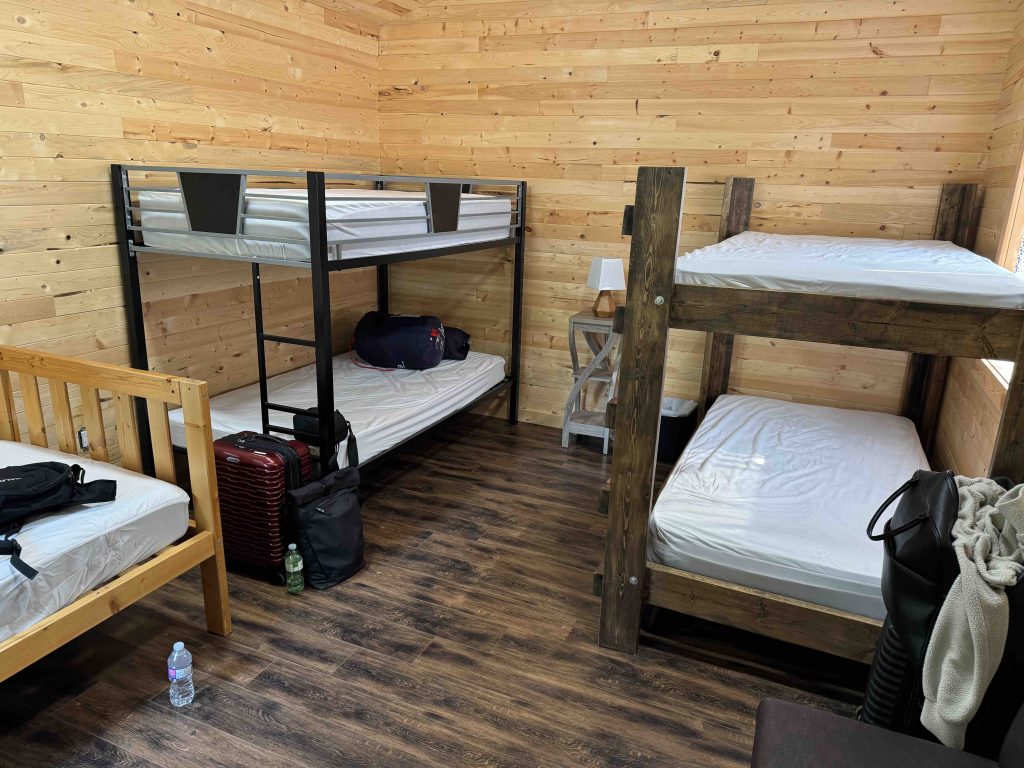
Bear heads and Beaver balls
Immersion is the name of the game at kâniyâsihk Culture Camp. No sooner had we packed away our bags, and had a tour of the camp lands with Zak, than we were playing “show and tell, guess and smell.”
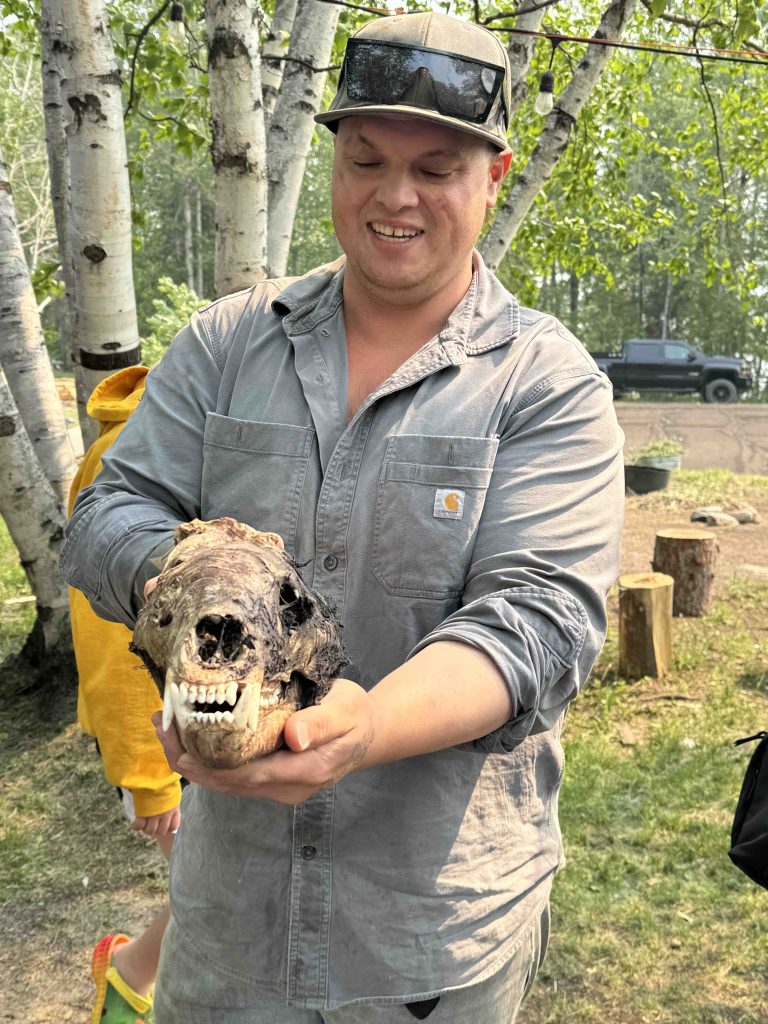
No doubt a game he rejoices in with guests to test their comfort limits, it’s not every day you get to hold a decomposing bear head, or sniff beaver balls.
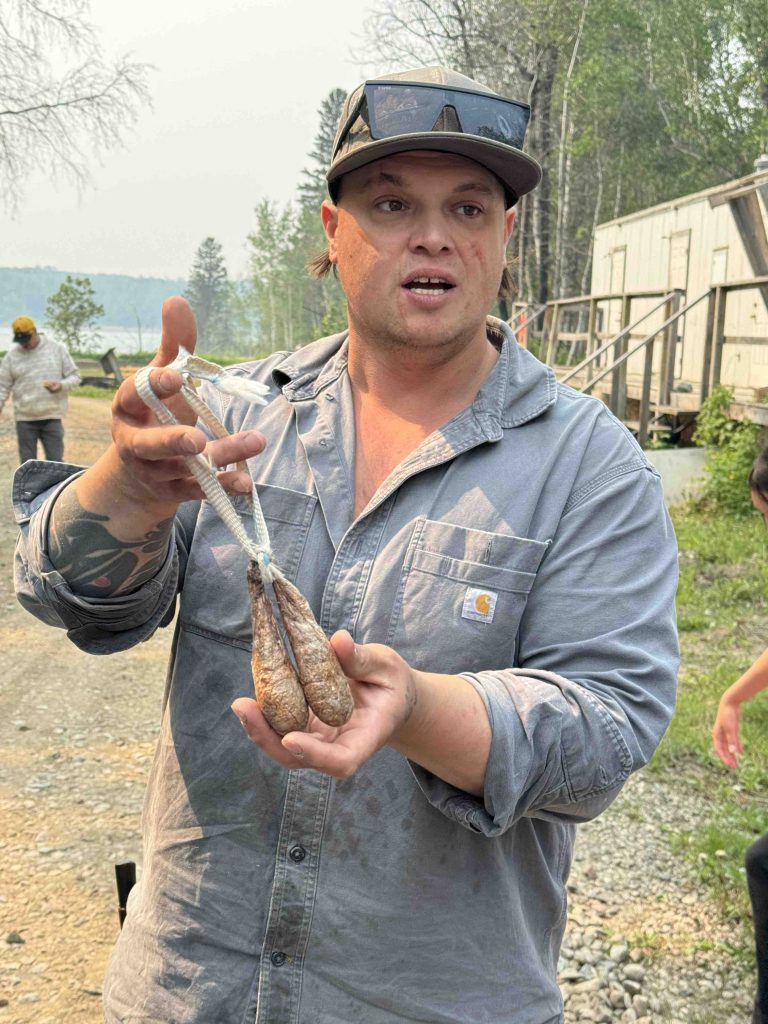
In case you’re wondering, a specific part of the gland smells sweet, like jam. Turns out this is how beavers identify each other. The learning had just began.
Net fishing
Learning by doing is the teaching style here. We were soon put to work preparing fishing nets. Untangling and methodically folding large nets to dispatch from a boat, was a group effort. It was enlightening to witness this method in action, as a way to snag fish swimming by, rather than drop net and scooping them, which is what first came to mind when Zak said they fish with nets.
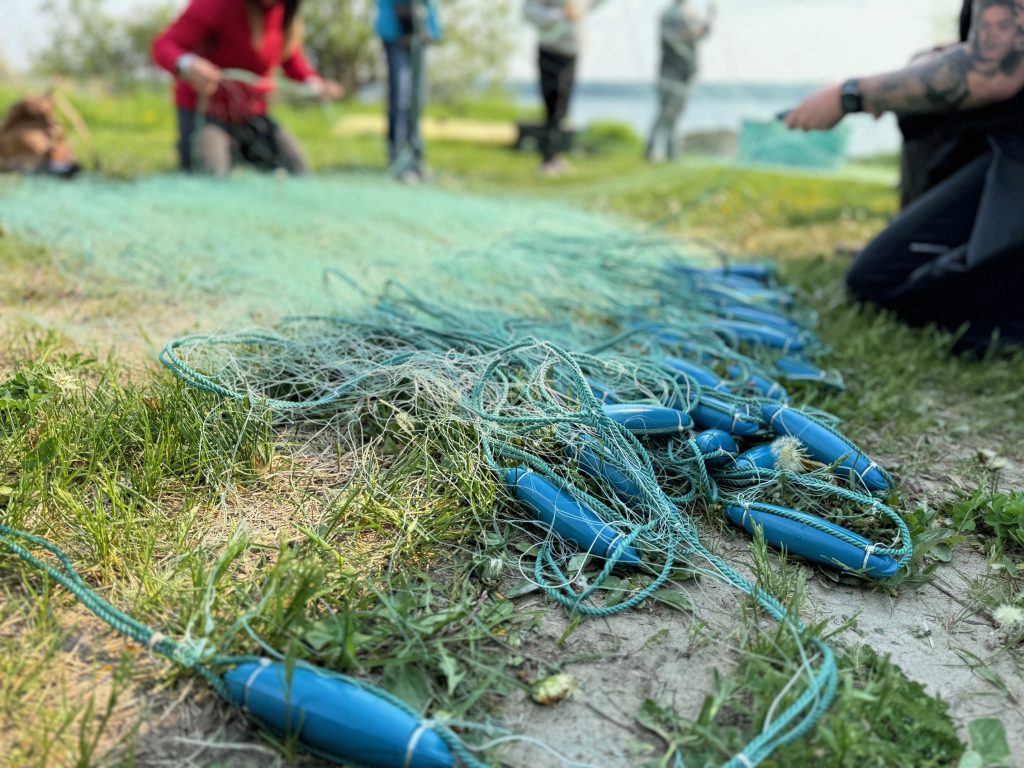
It was certainly more efficient than a single hook and line too, since we caught 11 fish by the following morning. The assortment of whitefish, sucker, pickerel (walleye) and maria would become lunch the next day.
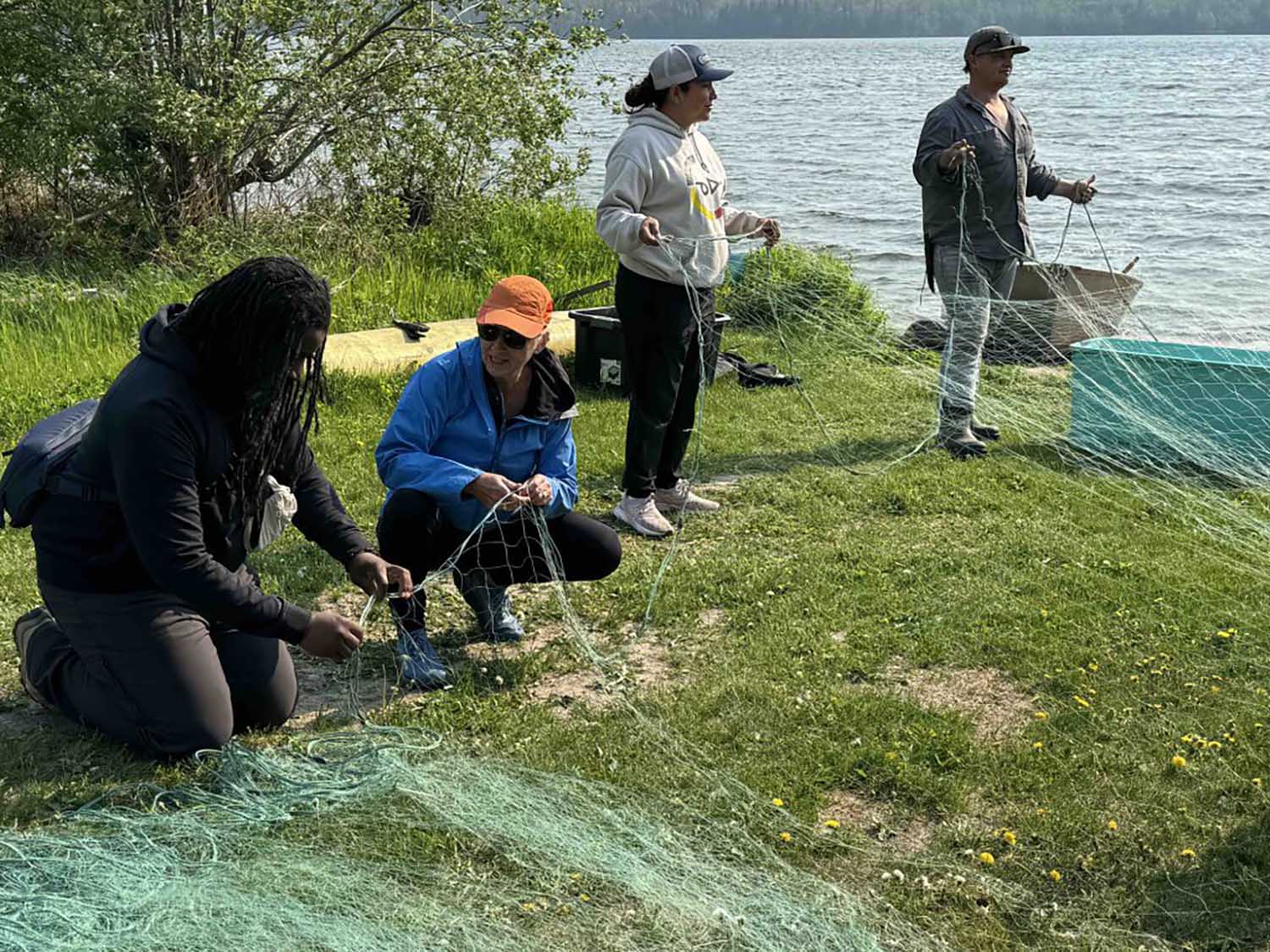
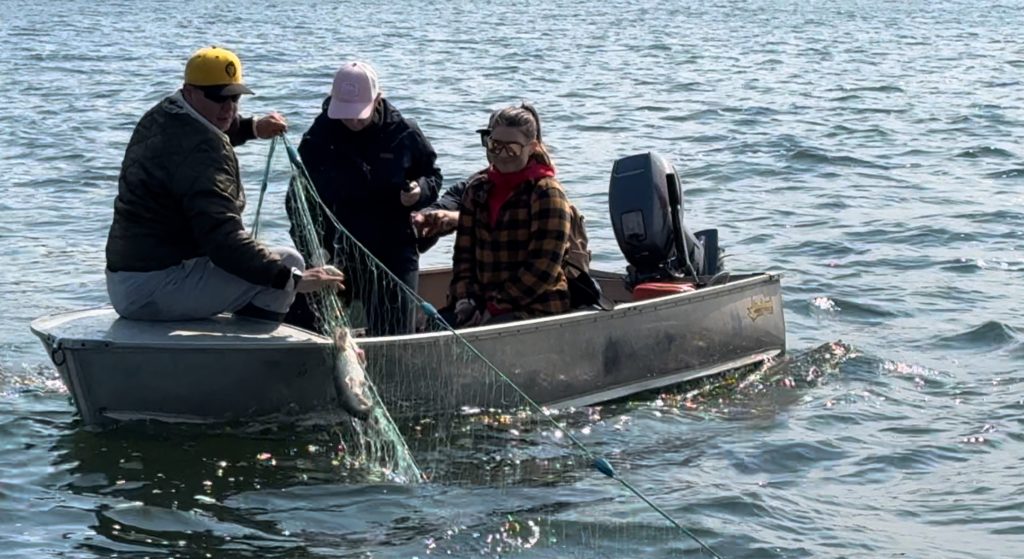
Learning to net fish, collect the catch by boat, and later clean the fish – including scaling, gutting and filleting was just all part of the experience. We all piled in. The guts and fish scales were flying. I later found one in my hair when it glistened in the mirror. We learned that even the scales have purpose for the Cree, making jewelry and being added to decorate hides along with beads.
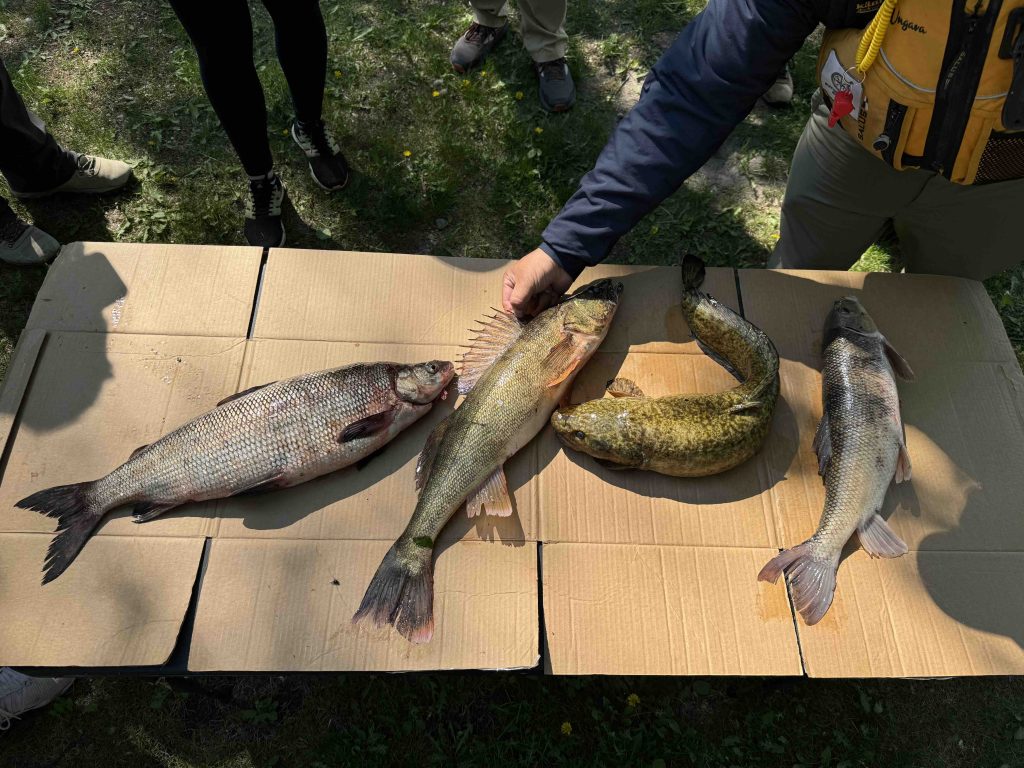
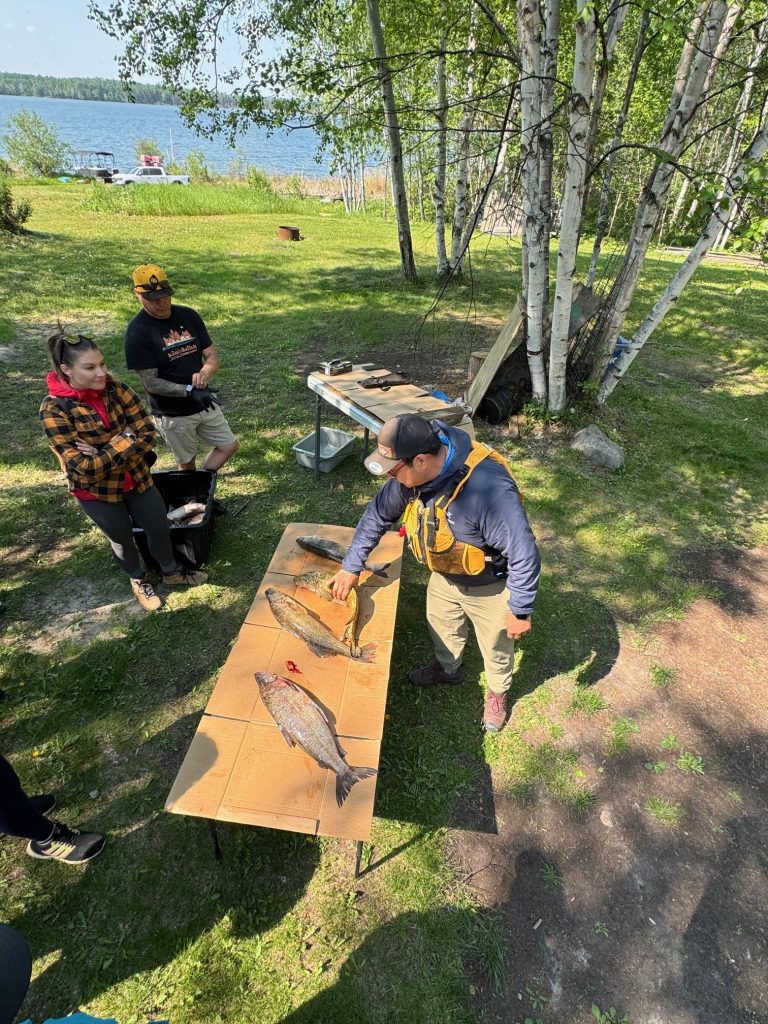
Scraping elk hides
Remember that strung out hide I referenced upon arrival? Turns out it would become another project we would participate in. Both scraping the fur from the hide, and tanning it.
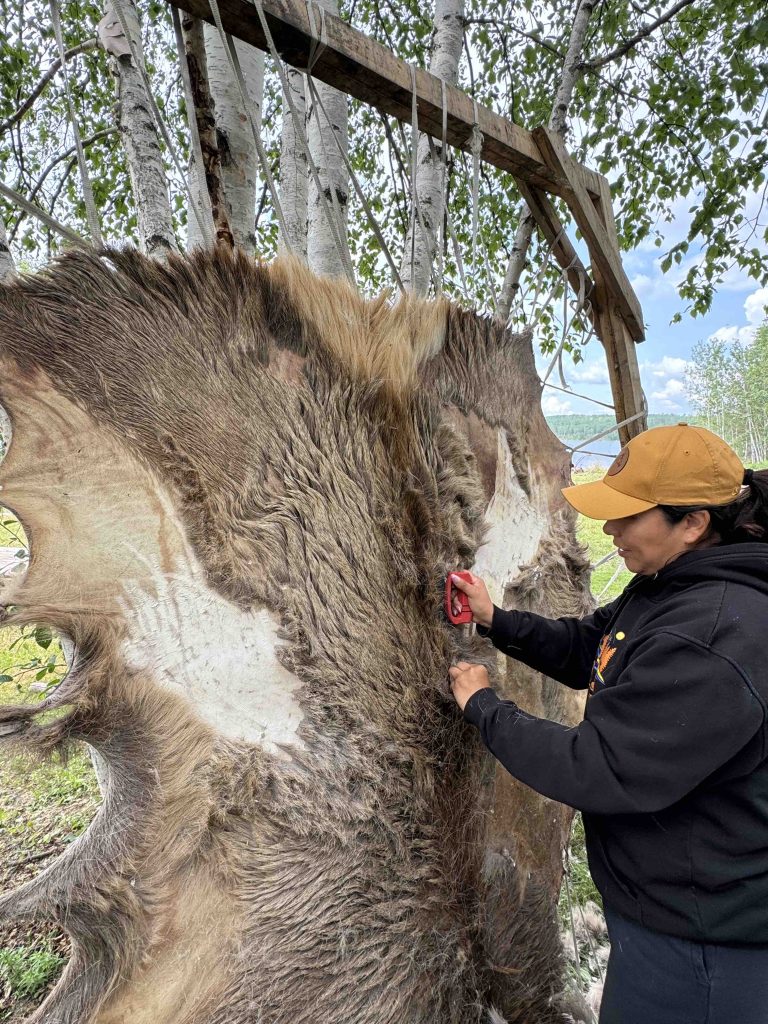
While Darla demonstrated the scraping technique and tools used, we all got in on the action later.
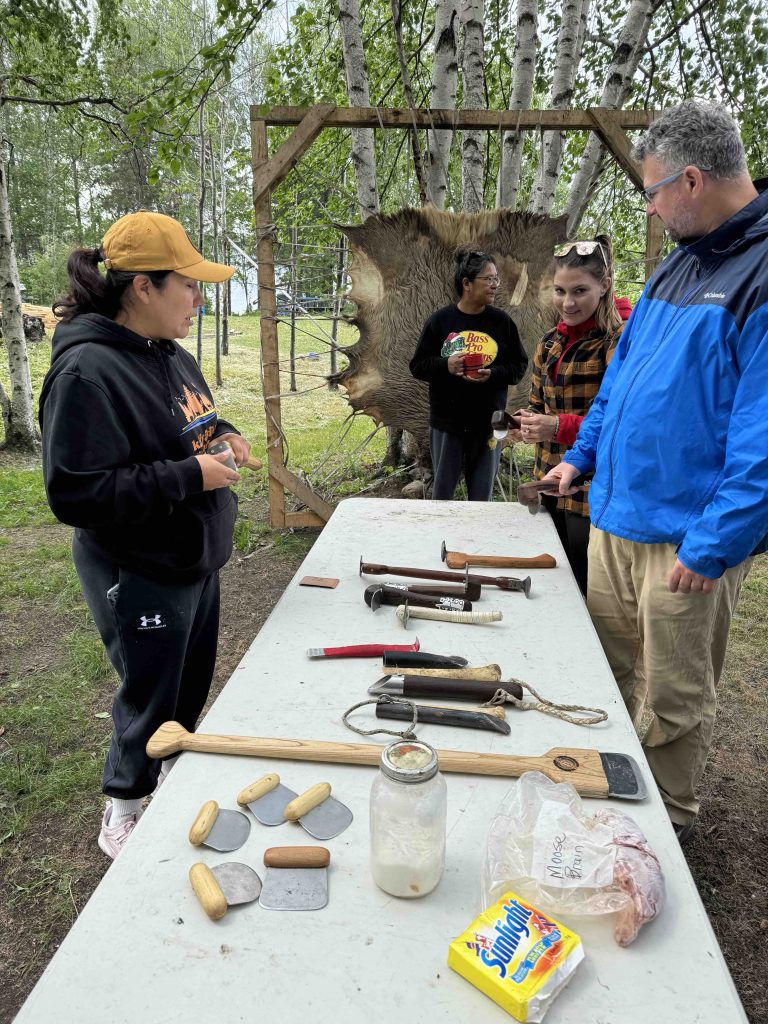
The fur was literally flying as we all shaved the hide. “Shaving” implies it was a smooth process however. In actual fact, sounds made with the pressure applied – both grunts of effort and the sound of a metal edge dragging along the hide, made it a pretty violent shave.
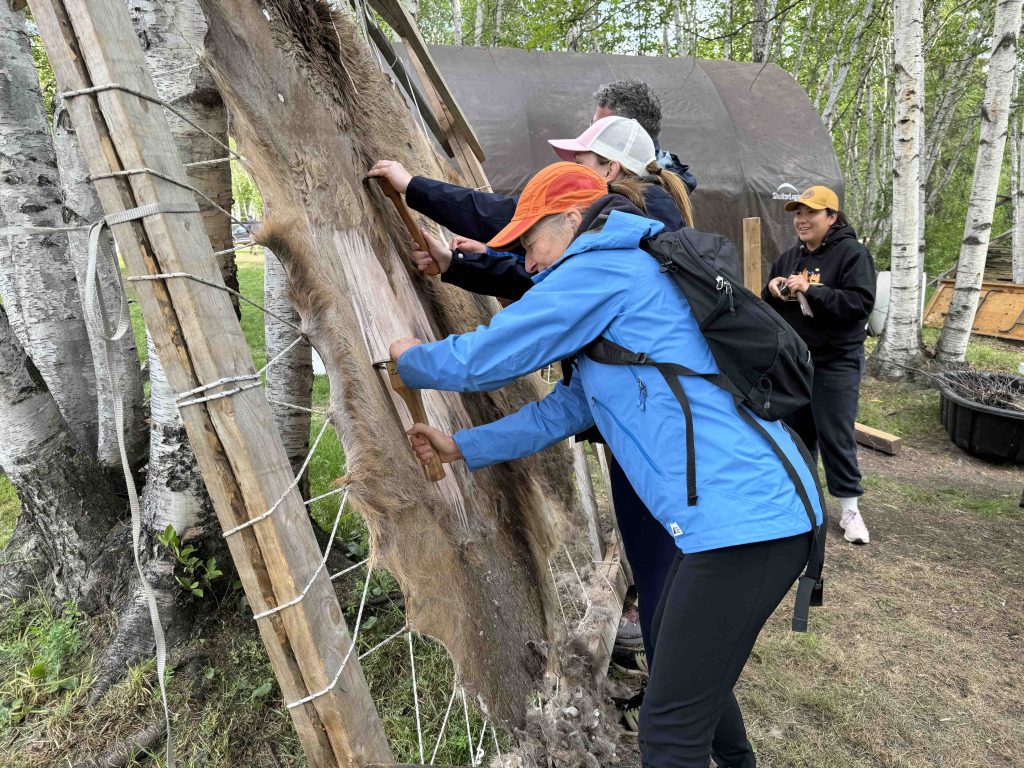
While it was amusing to watch us white folk do our best at scraping, Darla was the master. It was heartwarming to witness her sister Carmen teaching her young daughter the art. That is what kâniyâsihk Culture Camp is all about – preserving indigenous ways and passing down knowledge to the next generation.
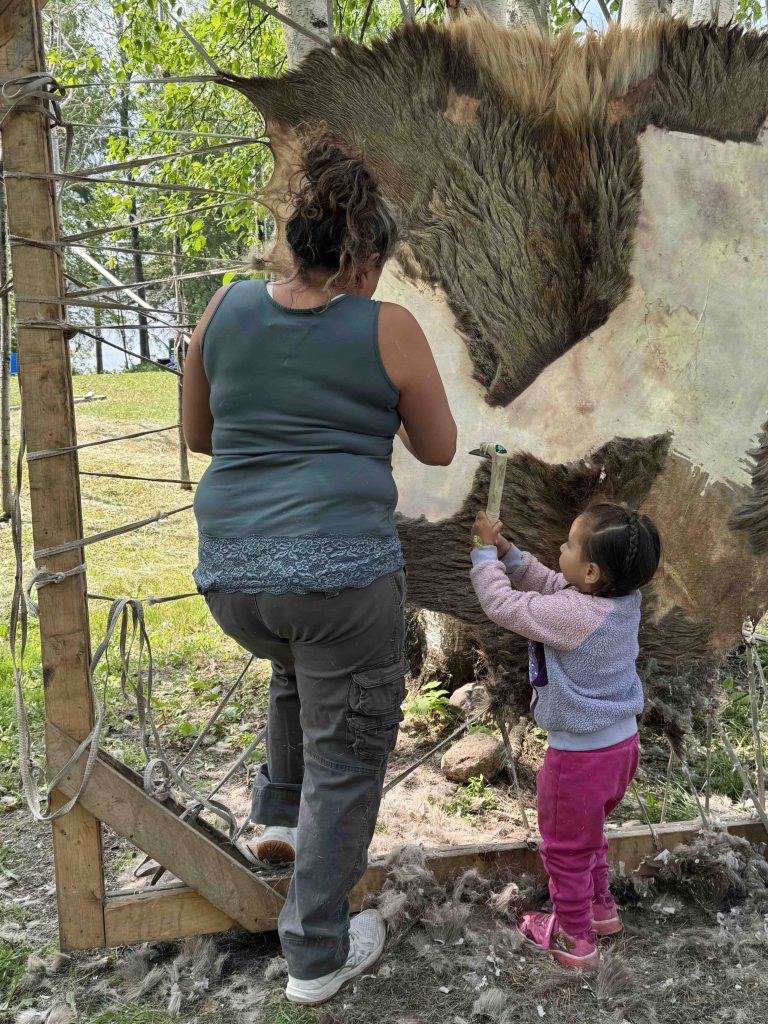
Tanning hides with moose brains
Getting down and dirty with moose brains squished between your fingers may not be for everyone, but this crowd embraced it even more than cleaning and gutting fish.
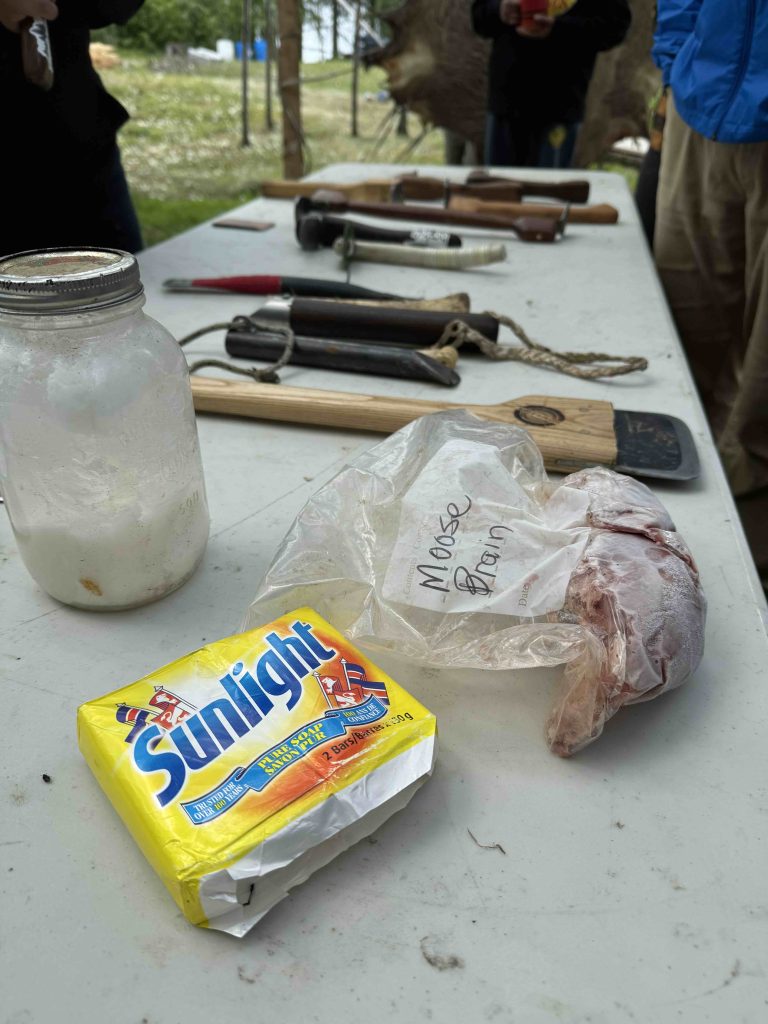
Moose brain mixed with water, plus shaved Sunlight bar soap added to a boil up, created the solution used for tanning hides. Down on all fours, rubbing the solution into the hide, we did our best to turn it into soft pliable leather.
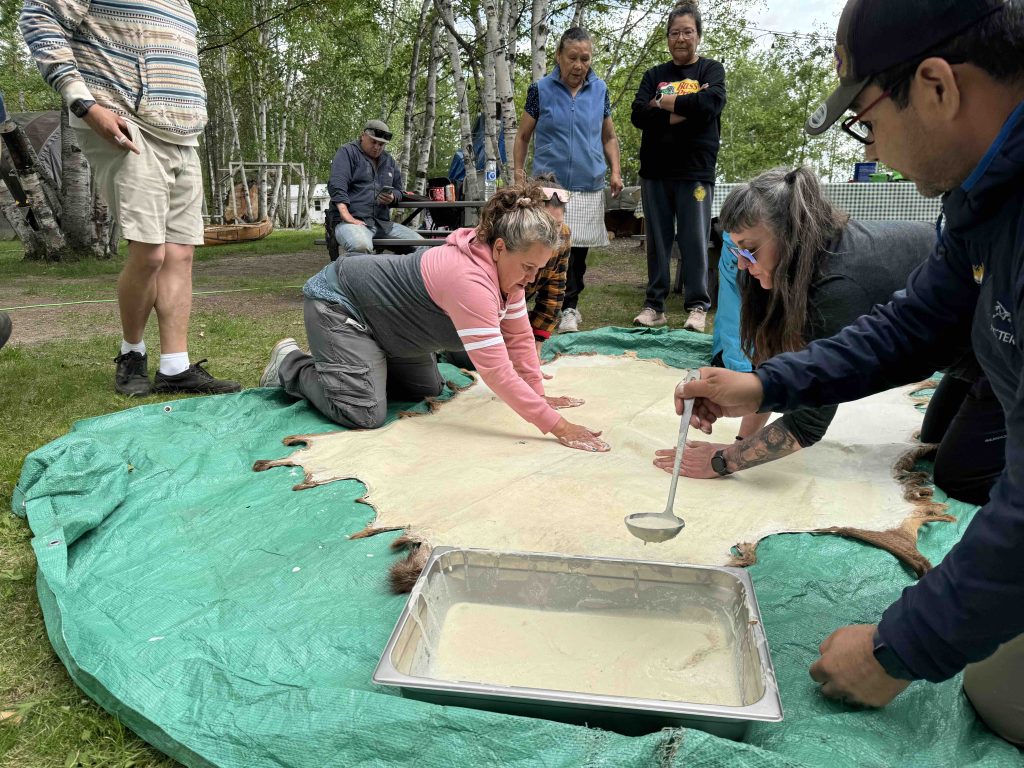
There’s not much the Cree don’t put to good use when taking a majestic creature like an elk, moose or bear. They put creativity to work, purposing the hides into moccasins, clothing, and drums, plus feeding their families with the meat.
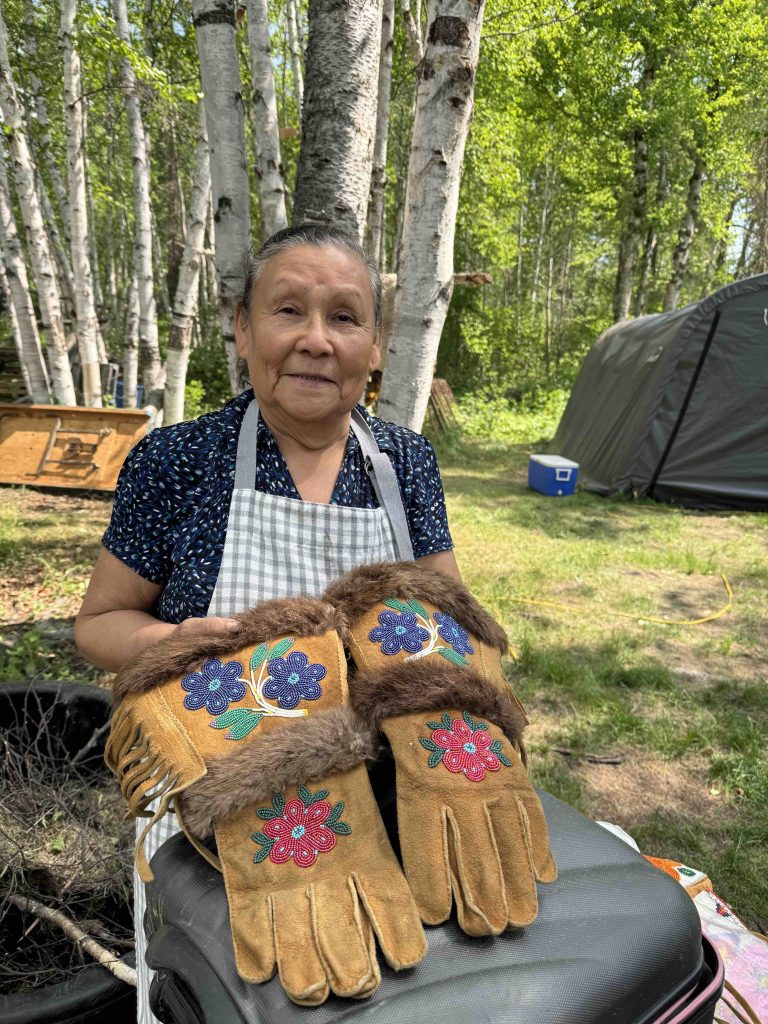
There won’t be a test at the end, but in case you’re wondering there are 13 stages in the hide preparation process.
- Skinning
- Stringing
- Fleshing
- Drying
- Scraping
- Braining
- Smoking – part one
- Folding
- Soaking – in warm brain again
- Wringing
- Stretching until soft
- Sewing into sock tube
- Smoking – part two, the final stage
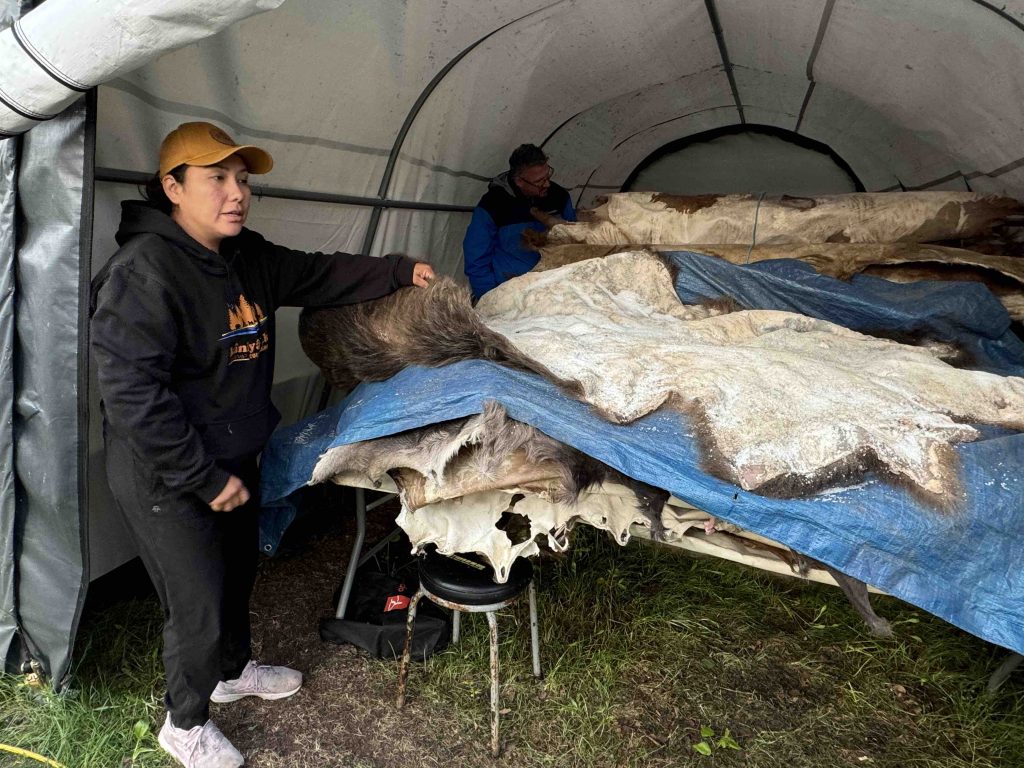
That elk hide we scraped and brained was at stage five and six. Turns out we would later help cut and prepare the meat from that magnificent beast, for a fresh cooked stew.
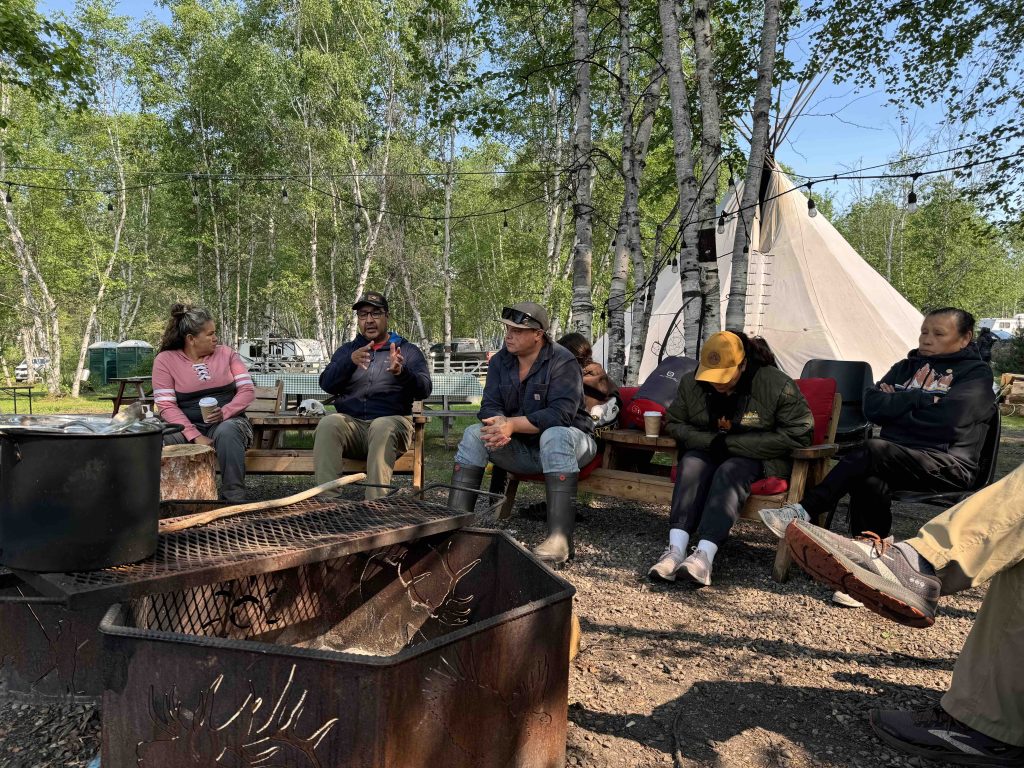
Gathered around the fire pit, with Kevin sharing Indigenous stories, the circle of inclusion was multi-generation and powerful, as we dined and listened. It was an honour to be included.
Did I mention I’ve yet to miss cell phone service or the internet?
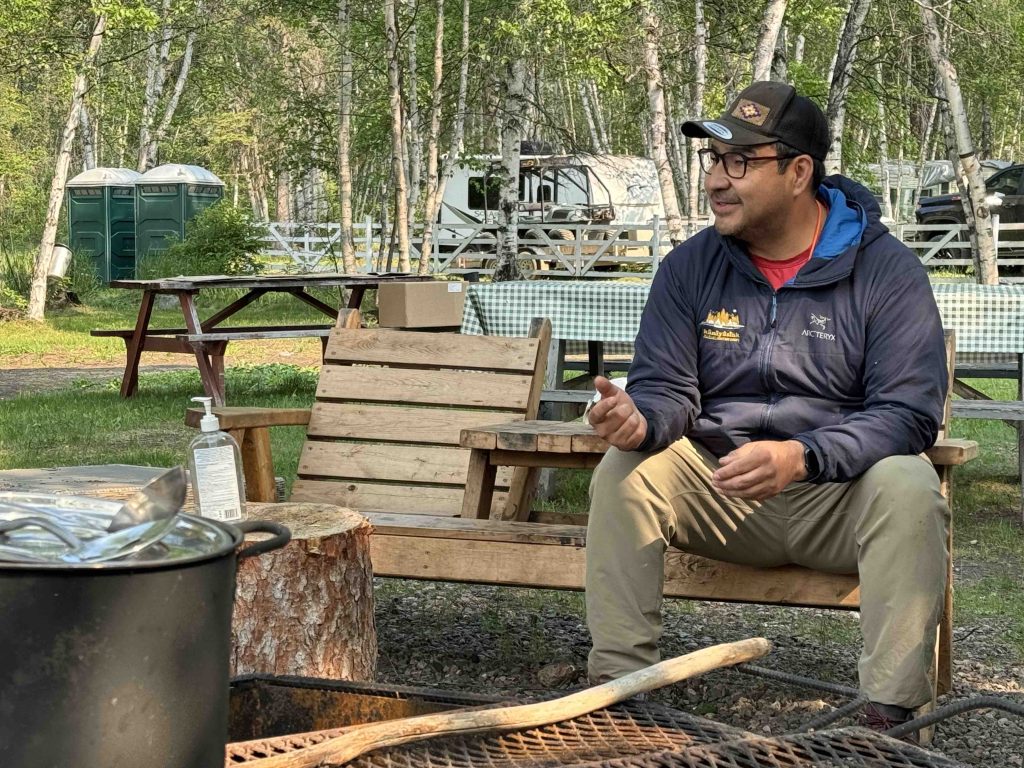
The pipe ceremony – a rare Saskatchewan indigenous experience
Just when I thought the whole experience couldn’t get much more intimate or thoughtfully authentic, Kevin invited us to participate in the traditional pipe ceremony of his people. We entered the tipi with Kevin explaining the significance of the structure, and its symbolism in a matriarchal society. We learned that the 33’ tipi represents a woman, the 15 poles her strength. The door entrance, representing where life is born, always facing south. Women are the keepers of knowledge, giving life and love in Cree society. In a world at times appearing to run astray, largely at the hands of male power struggles, it was a timely reminder of the lessons we can all learn at the hands of our First Nations founders.
Inside the tipi a fire was burning at the centre for warmth. We gathered, men to the left, women on the right. After some nervous laughter about whether we should inhale or not, it was evident that we didn’t know what to expect. Then Kevin began the ceremony. What followed could not be photographed, nor shared out of respect. It can only be experienced. The feeling of community, shared friendship and appreciation, as the burning sweet grass was passed, was spiritual. A once in a life memory.
On the lake
We ventured out on the lake a couple times. Once with Kevin at sunset, as he shared an Indigenous story and teaching about Potato Island and the mysterious mini horses who occupied it.
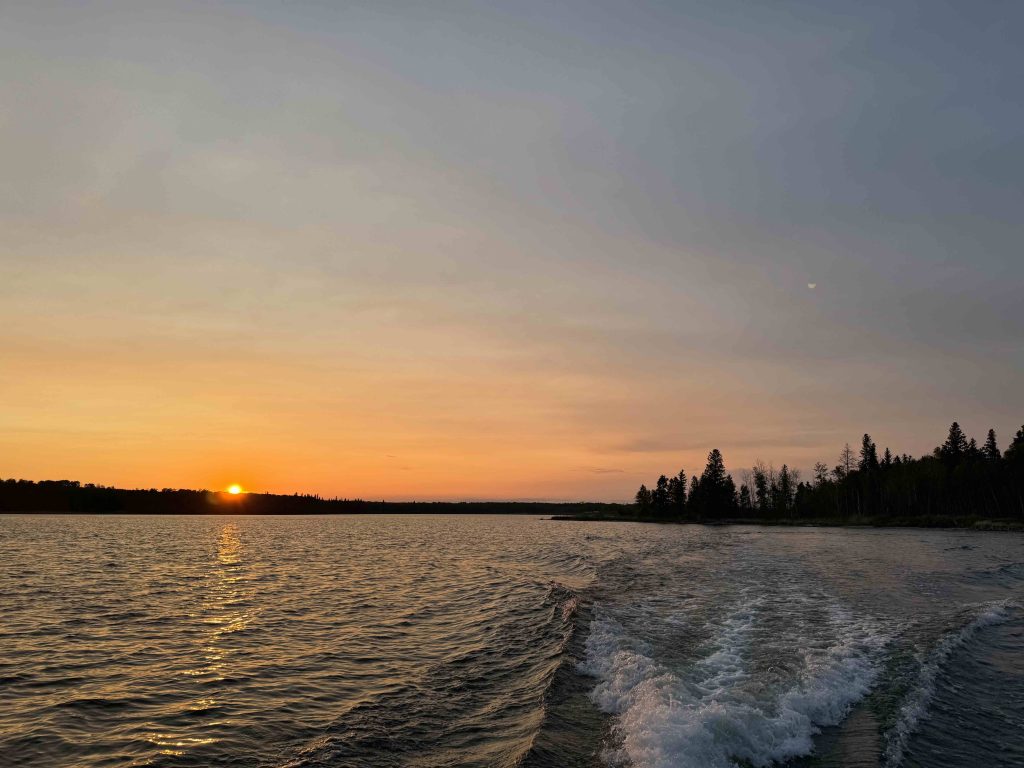
We ventured on the lake a second time with Zak, to check the fish nets, and tour beaver colonies – gathered piles of sticks along the shore. According to Zak, they can tell how harsh the winter will be based on how far underwater sticks are away from the beaver’s home. Further away indicates a longer winter. We also learn that otters sometimes move in and live with beavers in their home. When food becomes sparse, they will eat the beavers’ young. A freeloading, carnivore tenant – who knew that about the sweet looking otter?
Around the fire
We gathered around the outdoor fire pit multiple times, to eat, have tea, and just talk – sharing fellowship. During one of these sessions Kevin shared the story of a young woman who disobeyed the elders, and as a result, later give birth to a child which was a cross between a human and a fish. She would have to release the child into the lake each evening, denying her the reward of full motherhood. While some stories seemed implausible, Kevin assured us that tales like this served a purpose – to carry warnings about obedience, and remind youth about safety.
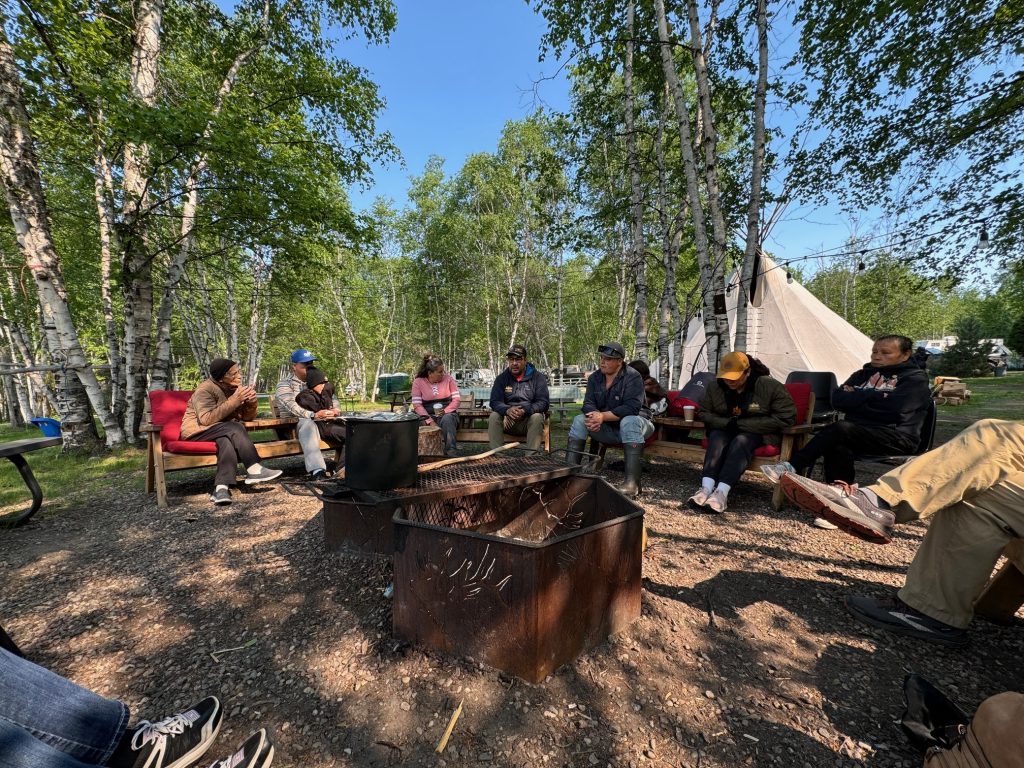
Birch bark canoe
Traditional canoe making is alive and well at kâniyâsihk Culture Camp. Canoe construction takes a full month, from harvesting cedar and birch trees – including shaping the cedar wood frame and thwarts, to molding the birch bark covering, held together with a paste of tree pitch.
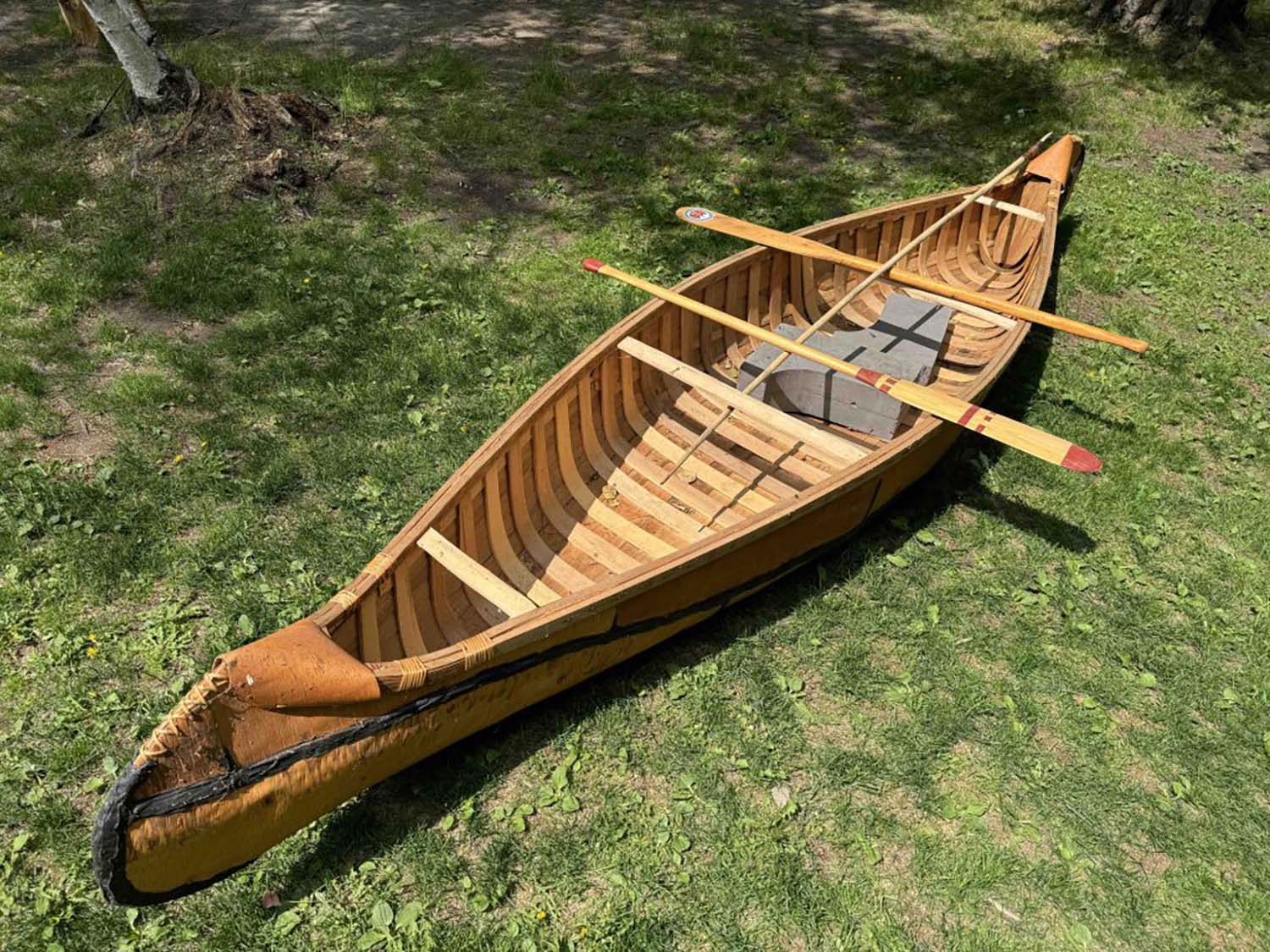
The canoe pictured here was used in the 2023 Disney movie, produced by David Lowry, called Peter Pan & Wendy. The movie was filmed partially on site at the camp. Kevin, who is also a polyglot of Indigenous languages and teacher at the First Nations University of Canada in Regina, was entrusted with translating Hollywood script lines into Cree. His mother, Matilda, did the Cree voice overs for the movie.
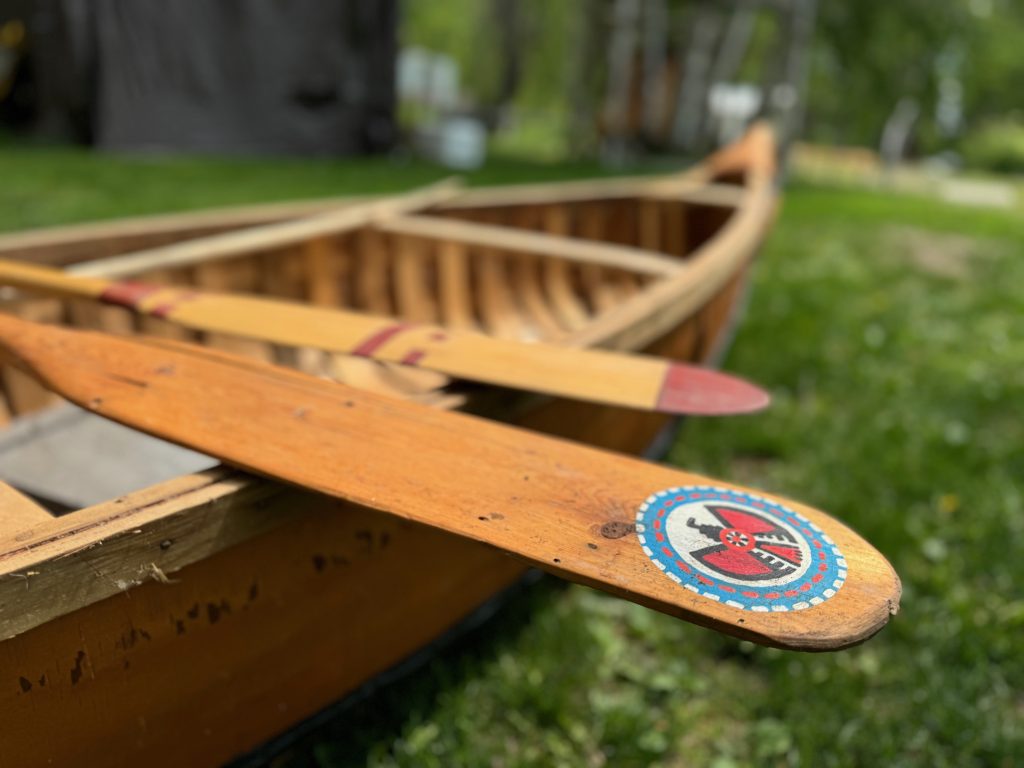
Counting the winters
In a country obsessed with talk about the weather, quantifying one’s age as “the number of winters” feels very Canadian. But the practice is rooted in indigenous culture. “At the end of the day, we’re always preparing for winter,” Kevin said. It would be yet another learning I would take home, and put into practice with much amusement, at the next age related question.
Until we meet again – Never saying goodbye
As Kevin noted at departure, “Until we meet again” is the Cree farewell, because there is no word for goodbye in their language. “Canada as a whole has started the relationship with us, but they haven’t seen the beauty of it, or this. That’s the story we want to share.”
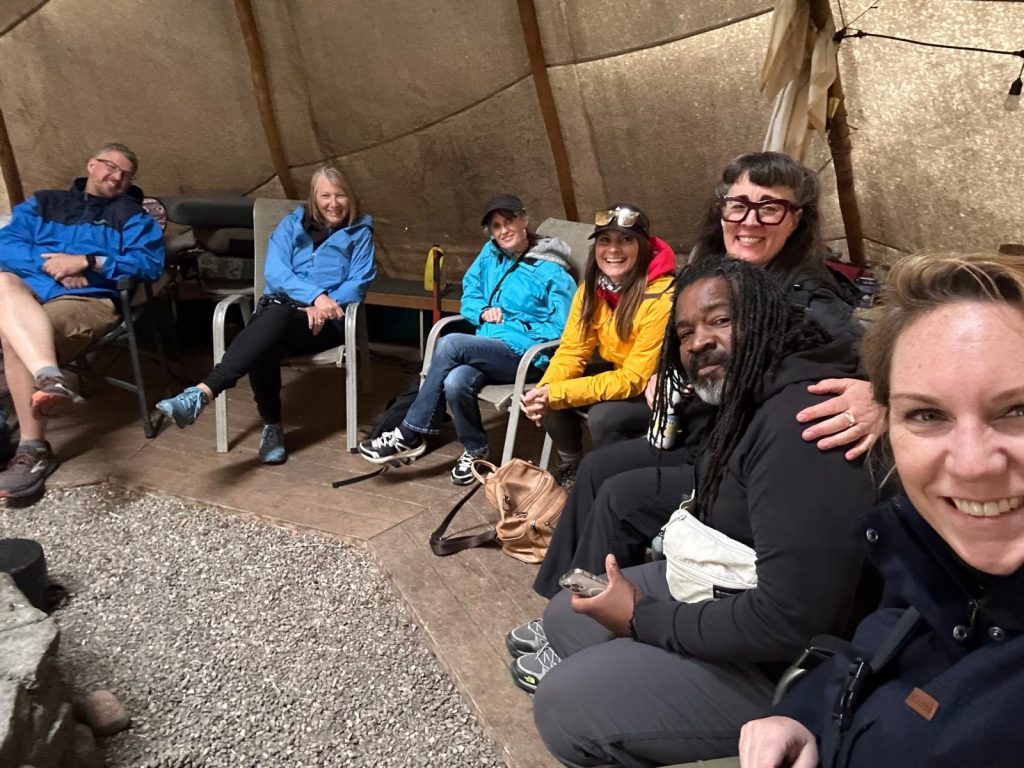
My world was forever changed by this Saskatchewan indigenous tourism experience. Spending time at kâniyâsihk Culture Camp, learning how they preserve traditional ways to educate their younger generations, as well as non-indigenous populations curious to explore, was life altering.
Who is this experience for? Beyond the camp’s initial desire to educate their own?
It’s not so much a target audience, but a group defined by values, interests and openness to learning in the authentic, slightly roughing it environment. I’d say it’s people who love learning, who are spiritually mature, open minded and accepting across race, religion and gender. But also people who appreciate the beauty of exchanging some comfort for an authentic outdoors experience. Folks ready to ruff it a bit along the way. The camp has hosted school and community groups in the past. And they have plans to build a commercial kitchen on site, to replace the previous one which burned down, making hosted groups a little easier, while also helping guests learn more about Indigenous foods and preparation. Certainly the recent addition of guest cabins indicates a desire to offer the experience more broadly.
And one more thing about who this experience is for…
I’d say someone who doesn’t mind having beaver balls pushed against their face for a sniff. Because Zak is sure to test you!
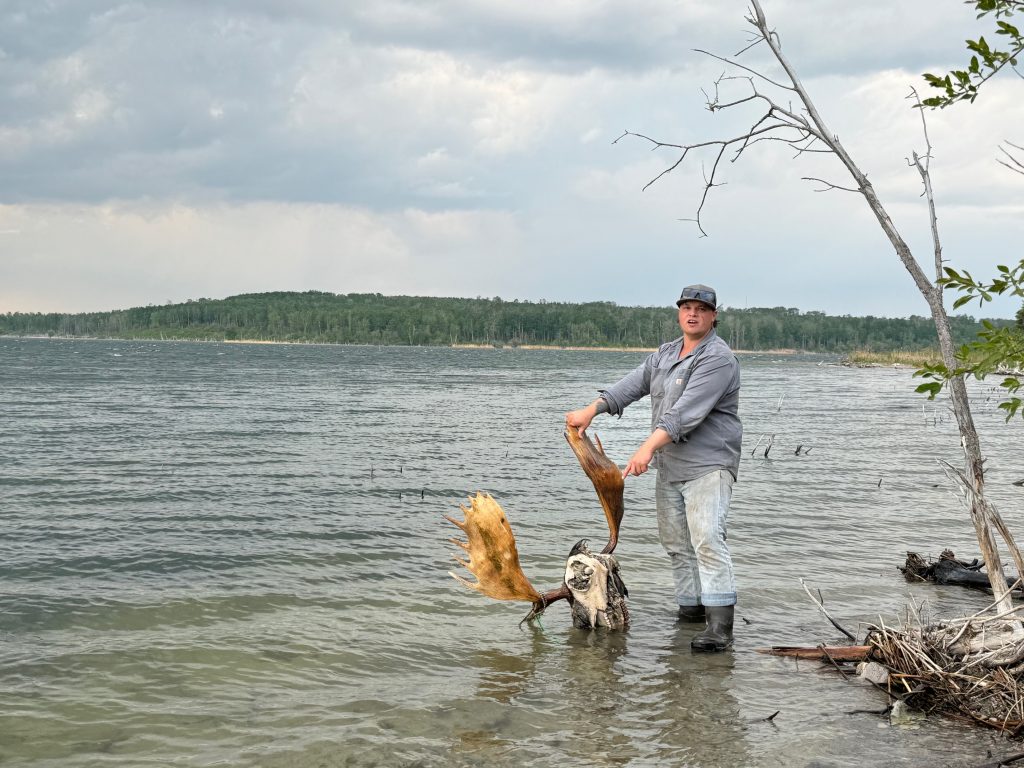
Learn more about Saskatchewan in this post: Water’s Edge Eco Lodge: an Indigenous Tourism Saskatchewan experience


